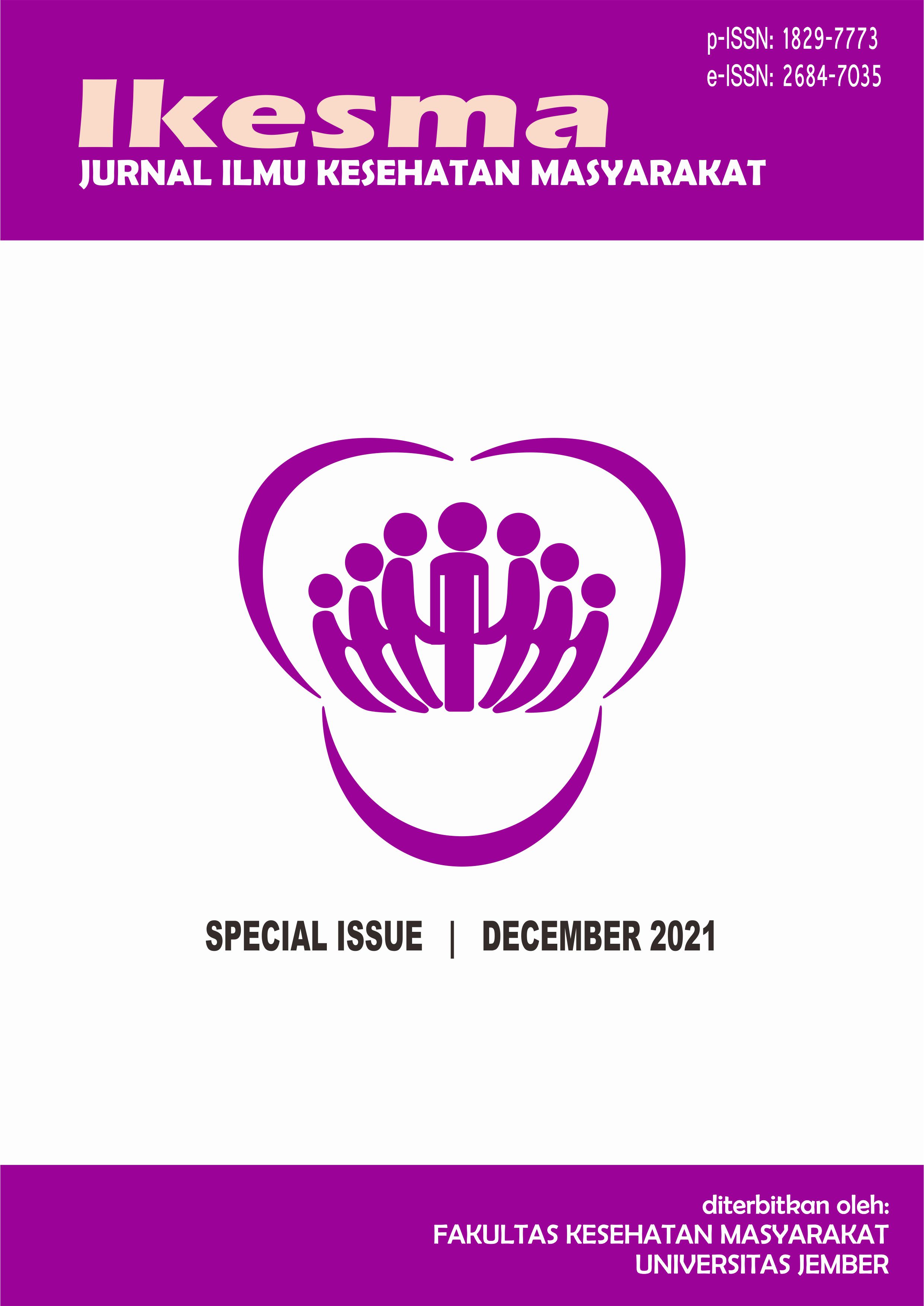FAKTOR PREDISPOSISI IMPLEMENTASI SUAMI SIAGA SELAMA PANDEMI COVID-19 DI KABUPATEN JEMBER
DOI:
https://doi.org/10.19184/ikesma.v0i0.27174Keywords:
Program Suami Siaga, Pengetahuan Suami, Pemberdayaan SuamiAbstract
Angka kematian Ibu meningkat selama masa pandemic COVID-19 pada tahun 2020 sebagai dampak kebijakan pembatasan kegiatan sosial. Akses masyarakat terhadap layanan kesehatan maternal menjadi terbatas sehingga penanganan komplikasi ibu hamil, bersalin, dan nifas menjadi terlambat. Suami memegang peranan penting dalam mencegah terjadinya keterlambatan tersebut melalui implementasi program Suami Siaga. Tujuan penelitian adalah untuk mengidentifikasi faktor predisposisi yang berhubungan dengan implementasi suami siaga. Penelitian ini merupakan penelitian analitik observasional dengan desain studi cross-sectional di wilayah Pusat Kesehatan Masyarakat Panti, kabupaten Jember selama Agustus sampai dengan November 2020. Sampel penelitian sejumlah 170 orang yang dipilih secara acak menggunakan cluster random sampling. Instrumen penelitian menggunakan kuesioner terstruktur untuk mengukur implementasi suami siaga kemudian data yang diperoleh dianalisis menggunakan uji chi-square. Hasil penelitian menunjukkan bahwa sebagian besar suami termasuk dalam kategori suami tanggap dan siaga (85,88%). Faktor predisposisi yang berhubungan dengan implementasi suami siaga antara lain usia suami (p-value = 0,008), pengetahuan suami tentang persiapan persalinan dan pencegahan komplikasi (p-value = 0,002), dan jarak tempat tinggal ke fasilitas kesehatan (p-value = 0,000). Oleh karena itu, tenaga kesehatan di fasilitas pelayanan kesehatan perlu meningkatkan kegiatan edukasi dan sosialisasi terkait program Suami Siaga pada ibu hamil dan suami selama antenatal care sebagai pencegahan kematian ibu selama pandemic COVID-19.
Downloads
References
2] Baraki, Z., Wendem, F., Gerensea, H., & Teklay, H. (2019). Husbands involvement in birth preparedness and complication readiness in Axum town, Tigray region, Ethiopia, 2017. BMC Pregnancy and Childbirth, 19(1), 1–8. https://doi.org/10.1186/s12884-019-2338-z
3] Belda, S. S., & Gebremariam, M. B. (2016). Birth preparedness, complication readiness and other determinants of place of delivery among mothers in Goba District, Bale Zone, South East Ethiopia. BMC Pregnancy and Childbirth, 16(1), 1–12. https://doi.org/10.1186/s12884-016-0837-8
4] Bintabara, D., Mohamed, M. A., Mghamba, J., Wasswa, P., & Mpembeni, R. N. M. (2015). Birth preparedness and complication readiness among recently delivered women in chamwino district, central Tanzania: A cross sectional study “Obstetrics.†Reproductive Health, 12(1), 1–8. https://doi.org/10.1186/s12978-015-0041-8
5] Bitew, Y., Awoke, W., & Chekol, S. (2016). Birth Preparedness and Complication Readiness Practice and Associated Factors among Pregnant Women, Northwest Ethiopia. International Scholarly Research Notices, 2016, 1–8. https://doi.org/10.1155/2016/8727365
6] Bogale, B., Astatkie, A., & Wakgari, N. (2019). Effect of Pregnant Mothers’ Forum Participation on Birth Preparedness and Complication Readiness among Pregnant Women in Dale District, Southern Ethiopia: A Comparative Cross-Sectional Study. Journal of Pregnancy, 2019. https://doi.org/10.1155/2019/1429038
7] Debelew, G. T., Afework, F., & Yalew, A. W. (2014). Factors affecting birth preparedness and complication readiness in Jimma Zone, Southwest Ethiopia: A multilevel analysis. Pan African Medical Journal, 19, 1–14. https://doi.org/10.11604/pamj.2014.19.272.4244
8] Dinas Kesehatan Provinsi Jawa Timur. (2020). Profil Kesehatan Provinsi Jawa Timur 2020. In Dinas Kesehatan Provinsi Jawa Timur. Dinas Kesehatan Provinsi Jawa Timur. www.dinkesjatimprov.go.id
9] Florence, M., Atuhaire, C., Nkfusai, C. N., Shirinde, J., & Cumber, S. N. (2019). Knowledge and practice of birth preparedness and complication readiness among pregnant women attending antenatal clinic in openzinzi hciii, adjumani district, Uganda. Pan African Medical Journal, 34, 1–9. https://doi.org/10.11604/pamj.2019.34.46.16869
10] Gebreyesus, H., Berhe, T., & Teweldemedhin, M. (2019). Birth preparedness as a precursor to reduce maternal morbidity and mortality among pregnant mothers in Medebay Zana District, Northern Ethiopia. BMC Research Notes, 12(1), 1–6. https://doi.org/10.1186/s13104-019-4331-z
11] Gize, A., Eyassu, A., Nigatu, B., Eshete, M., & Wendwessen, N. (2019). Men’s knowledge and involvement on obstetric danger signs, birth preparedness and complication readiness in Burayu town, Oromia region, Ethiopia. BMC Pregnancy and Childbirth, 19(1), 1–9. https://doi.org/10.1186/s12884-019-2661-4
12] Gudayu, T. W., & Araya, B. M. (2019). Outcomes among Mothers Who Gave Birth in the Health Facility: Does Birth Preparedness and Complication Readiness Have a Role? Obstetrics and Gynecology International, 2019. https://doi.org/10.1155/2019/5147853
13] Gul, X., Hameed, W., Hussain, S., Sheikh, I., & Siddiqui, J. U. R. (2019). A study protocol for an mHealth, multi-centre randomized control trial to promote use of postpartum contraception amongst rural women in Punjab, Pakistan. BMC Pregnancy and Childbirth, 19(1), 1–11. https://doi.org/10.1186/s12884-019-2427-z
14] Jember, D. K. K. (2018). Profil Kesehatan Kabupaten Jember Tahun 2018. Dinas Kesehatan Kabupaten Jember.
15] Kakaire, O., Kaye, D. K., & Osinde, M. O. (2011). Male involvement in birth preparedness and complication readiness for emergency obstetric referrals in rural Uganda. Reproductive Health, 8(1), 12. https://doi.org/10.1186/1742-4755-8-12
16] Kalisa, R., Smeele, P., van Elteren, M., van den Akker, T., & van Roosmalen, J. (2018). Facilitators and barriers to birth preparedness and complication readiness in rural Rwanda among community health workers and community members: a qualitative study. Maternal Health, Neonatology and Perinatology, 4(1), 1–7. https://doi.org/10.1186/s40748-018-0080-6
17] Kemenkes RI. (2017). Profil Kesehatan Indonesia. Kemenkes RI.
18] Kiataphiwasu, N., & Kaewkiattikun, K. (2018). Birth preparedness and complication readiness among pregnant women attending antenatal care at the faculty of medicine Vajira hospital, Thailand. International Journal of Women’s Health, 10, 797–804. https://doi.org/10.2147/IJWH.S185589
19] Kurniati, A., Chen, C. M., Efendi, F., Elizabeth Ku, L. J., & Berliana, S. M. (2017). Suami SIAGA: Male engagement in maternal health in Indonesia. Health Policy and Planning, 32(8), 1203–1211. https://doi.org/10.1093/heapol/czx073
20] Paulos, K., Awoke, N., Mekonnen, B., & Arba, A. (2020). Male involvement in birth preparedness and complication readiness for emergency referral at Sodo town of Wolaita zone, South Ethiopia: A cross sectional study. BMC Pregnancy and Childbirth, 20(1), 1–7. https://doi.org/10.1186/s12884-020-2758-9
21] Permatasari, E., Baroya, N., Ramani, A., Wicaksono, D. B. C., Luthfiyana, N. U., Kusumawardani, D. A., & Wati, D. M. (2021). Tantangan Proses Impelementasi Program Penurunan Angka Kematian Ibu di Wilayah Kerja Puskesmas Panti Kabupaten Jember. 12(7), 21–25.
22] Pervin, J., Tin Nu, U., Rahman, A. M. Q., Rahman, M., Uddin, B., Razzaque, A., Johnson, S., Kuhn, R., & Rahman, A. (2018). Level and determinants of birth preparedness and complication readiness among pregnant women: A cross sectional study in a rural area in Bangladesh. PLoS ONE, 13(12), 1–14. https://doi.org/10.1371/journal.pone.0209076
23] Santoso, H. Y. D., Supriyana, S., Bahiyatun, B., Widyawati, M. N., Fatmasari, D., Sudiyono, S., Widyastari, D. A., & Sinaga, D. M. (2017). Android Application Model of “Suami Siaga Plus†as an Innovation in Birth Preparedness and Complication Readiness (BP/CR) Intervention. Journal of Family & Reproductive Health, 11(1), 30–36. http://www.ncbi.nlm.nih.gov/pubmed/29114266%0Ahttp://www.pubmedcentral.nih.gov/articlerender.fcgi?artid=PMC5664987
24] Saputri, nurmala selly, Anbarani, maudita dwi, Toyamah, N., & Yumna, A. (2020). Dampak Pandemi Covid-19 pada Layanan Gizi dan Kesehatan Ibu dan Anak (KIA): Studi Kasus di Lima Wilayah di Indonesia. The SMERU Research Institute, 5, 1–8. https://smeru.or.id/id/content/dampak-pandemi-covid-19-pada-layanan-gizi-dan-kesehatan-ibu-dan-anak-kia-studi-kasus-di-lima
25] Soubeiga, D., Gauvin, L., Hatem, M. A., & Johri, M. (2014). Birth Preparedness and Complication Readiness (BPCR) interventions to reduce maternal and neonatal mortality in developing countries: Systematic review and meta-analysis. BMC Pregnancy and Childbirth, 14(1), 1–11. https://doi.org/10.1186/1471-2393-14-129
26] Tafere, T. E., Afework, M. F., & Yalew, A. W. (2018). Counseling on family planning during ANC service increases the likelihood of postpartum family planning use in Bahir Dar City Administration, Northwest Ethiopia: a prospective follow up study. Contraception and Reproductive Medicine, 3(1), 1–9. https://doi.org/10.1186/s40834-018-0081-x
27] Tancred, T., Marchant, T., Hanson, C., Schellenberg, J., & Manzi, F. (2016). Birth preparedness and place of birth in Tandahimba district, Tanzania: What women prepare for birth, where they go to deliver, and why. BMC Pregnancy and Childbirth, 16(1), 1–9. https://doi.org/10.1186/s12884-016-0945-5
28] Tsegaw, H. Z., Cherkos, E. A., Badi, M. B., & Mihret, M. S. (2019). Intended Pregnancy as a Predictor of Good Knowledge on Birth Preparedness and Complication Readiness: the Case of Northern Ethiopia Pregnant Mothers. International Journal of Reproductive Medicine, 2019, 1–10. https://doi.org/10.1155/2019/9653526
29] WHO, UNICEF, UNFPA, W. B. G. and the U. N. P. D. (2019). Maternal Mortality. Geneva, Switzerland: World Health Organization. https://www.who.int/news-room/fact-sheets/detail/maternal-mortality
30] Zepre, K., & Kaba, M. (2017). Birth preparedness and complication readiness among rural women of reproductive age in Aabeshige district, Gguraghe zone, SNNPR, Eethiopia. International Journal of Women’s Health, 9, 11–21. https://doi.org/10.2147/IJWH.S111769






